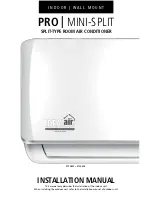
[8-3 Refrigerant Control Problems ]
- 246 -
HWE14040
GB
Cause
Check method and remedy
3.
RPM error of the outdoor unit FAN
Refer to the following page(s).
[8-7 Troubleshooting Outdoor Unit Fan Prob-
lems](page 257)
[7-3-3 Error Code [1302] (during operation)](page
173)
Motor failure or board failure, or airflow rate de-
crease due to clogging of the heat exchanger
The fan is not properly controlled as the outdoor
temperature cannot be precisely detected by the
temperature sensor.
The fan is not properly controlled as the pressure
cannot be precisely detected by the pressure sen-
sor.
4.
Long piping length
The cooling capacity varies greatly depending on the
pressure loss. (When the pressure loss is large, the
cooling capacity drops.)
Check the piping length to determine if it is contrib-
uting to performance loss.
Piping pressure loss can be estimated from the
temperature difference between the indoor unit
heat exchanger outlet temperature and the satura-
tion temperature (Te) of 63LS.
→
Correct the piping.
5.
Piping size is not proper (thin)
6.
Insufficient refrigerant amount
Protection works and compressor frequency does
not rise due to high discharge temperature.
Refer to item 1 (Compressor frequency does not
rise sufficiently.) on the previous page. (page 245)
Refer to the following page(s).[6-9 Evaluating and
Adjusting Refrigerant Charge](page 131)
7.
Clogging by foreign object
Check the temperature difference between in front
of and behind the place where the foreign object is
clogging the pipe (upstream side and downstream
side). When the temperature drops significantly, the
foreign object may clog the pipe.
→
Remove the foreign object inside the pipe.
8.
The indoor unit inlet temperature is excessively.
(Less than 15°C [59°F] WB)
Check the inlet air temperature and for short cy-
cling. Change the environment where the indoor
unit is used.
9.
Compressor failure
The amount of circulating refrigerant decreases due
to refrigerant leak in the compressor.
Check the discharge temperature to determine if
the refrigerant leaks, as it rises if there is a leak.
10.
LEV1 malfunction
Sufficient liquid refrigerant is not be supplied to the
indoor unit as sufficient sub cool cannot be secured
due to LEV1 malfunction.
Refer to the following page(s).[8-8 Troubleshooting
LEV Problems](page 258)
It most likely happens when there is little difference
or no difference between TH3 and TH6.
11.
TH3, TH6 and 63HS1 sensor failure or faulty wiring
LEV1 is not controlled normally.
Check the thermistor.
Check wiring.
12.
LEV2 actuation failure
A drop in the low pressure that is caused either by a
blockage of liquid pipe or by a pressure loss and the
resultant slowing of refrigerant flow causes a tenden-
cy for the discharge temperature to rise.
Refer to the following page(s).[8-8 Troubleshooting
LEV Problems](page 258)
Содержание PUHY-P1000
Страница 1: ......
Страница 11: ... 2 HWE14040 GB ...
Страница 27: ... 18 HWE14040 GB ...
Страница 40: ... 2 6 System Connection Example 31 HWE14040 GB 2 Restrictions ...
Страница 61: ... 52 HWE14040 GB ...
Страница 75: ... 66 HWE14040 GB ...
Страница 93: ... 84 HWE14040 GB ...
Страница 121: ... 112 HWE14040 GB ...
Страница 171: ... 6 11 Standard Operation Data Reference Data 162 HWE14040 GB ...
Страница 243: ... 7 9 Error Code Definitions and Solutions Codes 7000 7999 234 HWE14040 GB ...
Страница 295: ... 8 13 Troubleshooting Problems Using the LED Status Indicators on the Outdoor Unit 286 HWE14040 GB ...
Страница 297: ... 288 HWE14040 GB ...
Страница 334: ......
















































